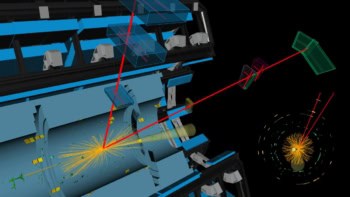The $287 m Asymmetric B Factory experiment at the Stanford Linear Accelerator Center (SLAC) in California has completed its first electron-positron collisions. The collisions create millions of rare, short-lived particles called B mesons inside a 1200-ton detector called BaBar. Scientists will use the experiment to look for charge-parity (CP) violation in B mesons. CP violation could explain why matter dominates the universe even though equal amounts of matter and antimatter should have been created in the big bang.
The collisions are termed “asymmetric” because the electrons are accelerated to 9 GeV – three times the energy of the positrons. As the two beams collide, they generate B mesons that decay within a trillionth of a second. The newly formed particles fly into the detector at different velocities, which makes it easier to separate the antimatter B mesons from the matter B mesons. In theory, the anti-B mesons should decay much faster than the normal B mesons.
Over 650 scientists and engineers from 73 institutions in the US, Canada, China, France, Germany, UK, Italy, Norway and Russia built the BaBar detector. It joins the KLOE experiment at the DAFNE accelerator in Italy as the second fully operational B factory. A third factory, at the KEK particle physics laboratory in Japan, will come online over the summer. All three teams expect to announce their first results next year.



